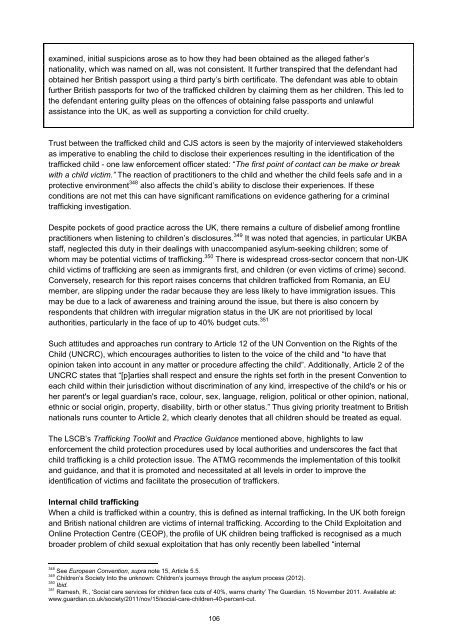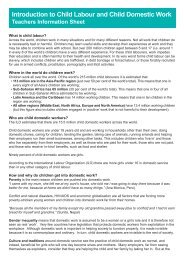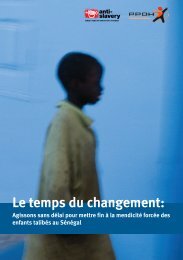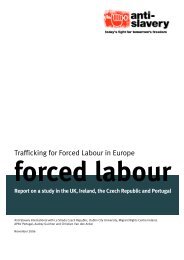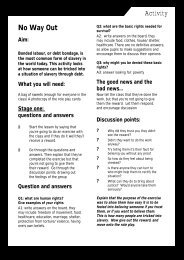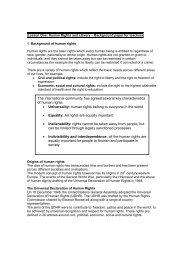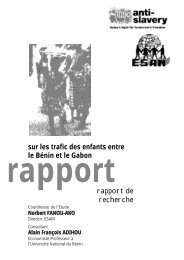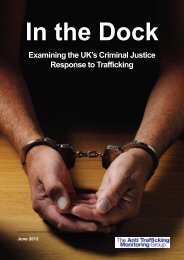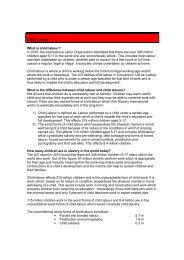examined, initial suspicions arose as to how <strong>the</strong>y had been obtained as <strong>the</strong> alleged fa<strong>the</strong>r’snationality, which was named on all, was not consistent. It fur<strong>the</strong>r transpired that <strong>the</strong> defendant hadobtained her British passport using a third party’s birth certificate. The defendant was able to obtainfur<strong>the</strong>r British passports for two of <strong>the</strong> trafficked children by claiming <strong>the</strong>m as her children. This led to<strong>the</strong> defendant entering guilty pleas on <strong>the</strong> offences of obtaining false passports and unlawfulassistance into <strong>the</strong> UK, as well as supporting a conviction for child cruelty.Trust between <strong>the</strong> trafficked child and CJS actors is seen by <strong>the</strong> majority of interviewed stakeholdersas imperative to enabling <strong>the</strong> child to disclose <strong>the</strong>ir experiences resulting in <strong>the</strong> identification of <strong>the</strong>trafficked child - one law enforcement officer stated: “The first point of contact can be make or breakwith a child victim.” The reaction of practitioners to <strong>the</strong> child and whe<strong>the</strong>r <strong>the</strong> child feels safe and in aprotective environment 348 also affects <strong>the</strong> child’s ability to disclose <strong>the</strong>ir experiences. If <strong>the</strong>seconditions are not met this can have significant ramifications on evidence ga<strong>the</strong>ring for a criminaltrafficking investigation.Despite pockets of good practice across <strong>the</strong> UK, <strong>the</strong>re remains a culture of disbelief among frontlinepractitioners when listening to children’s disclosures. 349 It was noted that agencies, in particular UKBAstaff, neglected this duty in <strong>the</strong>ir dealings with unaccompanied asylum-seeking children; some ofwhom may be potential victims of trafficking. 350 There is widespread cross-sector concern that non-UKchild victims of trafficking are seen as immigrants first, and children (or even victims of crime) second.Conversely, research for this report raises concerns that children trafficked from Romania, an EUmember, are slipping under <strong>the</strong> radar because <strong>the</strong>y are less likely to have immigration issues. Thismay be due to a lack of awareness and training around <strong>the</strong> issue, but <strong>the</strong>re is also concern byrespondents that children with irregular migration status in <strong>the</strong> UK are not prioritised by localauthorities, particularly in <strong>the</strong> face of up to 40% budget cuts. 351Such attitudes and approaches run contrary to Article 12 of <strong>the</strong> UN Convention on <strong>the</strong> Rights of <strong>the</strong>Child (UNCRC), which encourages authorities to listen to <strong>the</strong> voice of <strong>the</strong> child and “to have thatopinion taken into account in any matter or procedure affecting <strong>the</strong> child”. Additionally, Article 2 of <strong>the</strong>UNCRC states that “[p]arties shall respect and ensure <strong>the</strong> rights set forth in <strong>the</strong> present Convention toeach child within <strong>the</strong>ir jurisdiction without discrimination of any kind, irrespective of <strong>the</strong> child's or his orher parent's or legal guardian's race, colour, sex, language, religion, political or o<strong>the</strong>r opinion, national,ethnic or social origin, property, disability, birth or o<strong>the</strong>r status.” Thus giving priority treatment to Britishnationals runs counter to Article 2, which clearly denotes that all children should be treated as equal.The LSCB’s Trafficking Toolkit and Practice Guidance mentioned above, highlights to lawenforcement <strong>the</strong> child protection procedures used by local authorities and underscores <strong>the</strong> fact thatchild trafficking is a child protection issue. The ATMG recommends <strong>the</strong> implementation of this toolkitand guidance, and that it is promoted and necessitated at all levels in order to improve <strong>the</strong>identification of victims and facilitate <strong>the</strong> prosecution of traffickers.<strong>In</strong>ternal child traffickingWhen a child is trafficked within a country, this is defined as internal trafficking. <strong>In</strong> <strong>the</strong> UK both foreignand British national children are victims of internal trafficking. According to <strong>the</strong> Child Exploitation andOnline Protection Centre (CEOP), <strong>the</strong> profile of UK children being trafficked is recognised as a muchbroader problem of child sexual exploitation that has only recently been labelled “internal348See European Convention, supra note 15, Article 5.5.349Children’s Society <strong>In</strong>to <strong>the</strong> unknown: Children’s journeys through <strong>the</strong> asylum process (2012).350Ibid.351Ramesh, R., ‘Social care services for children face cuts of 40%, warns charity’ The Guardian. 15 November 2011. Available at:www.guardian.co.uk/society/2011/nov/15/social-care-children-40-percent-cut.106
trafficking”. 352 It states: “Whereas this helps to bring more focus to a previously underestimatedproblem, this new categorisation as trafficking leads to confusion in <strong>the</strong> UK context ... by making adistinction between those who are moved and those who are not, an arbitrary focus on <strong>the</strong>transportation part of <strong>the</strong> problem ra<strong>the</strong>r than <strong>the</strong> actual abuse is caused.” 353 Practitioners report thatthis lack of clarity around <strong>the</strong> definition of internal trafficking is confusing and misleading.It became apparent from <strong>the</strong> research that internal trafficking for o<strong>the</strong>r types of exploitation as well asfor foreign children is a concern. <strong>In</strong> particular, interviewed stakeholders reported Vietnamese boysdisappearing from local authority care and later discovered in cannabis farms in o<strong>the</strong>r parts of <strong>the</strong> UK.Much of <strong>the</strong> existing research around internal trafficking has focused on sexual exploitation of Britishchildren with high levels of media coverage in <strong>the</strong> past year on this homegrown issue, particularly inrelation to Operation Span (2012 – see below), Bullfinch (2011), Retriever (2010), Chalice (2010)Glover (2008), and recently R v Surin Uddin, Mohammed Sheikh and Hamza Alia. 354 However,reporting and public awareness of cases of internal trafficking of foreign children is still very low. Mostworryingly, <strong>the</strong>re were no reported cases of prosecutions (under trafficking legislation) against thosetrafficking Vietnamese children for cannabis cultivation, suggesting that this type of trafficker is actingwith impunity. All types of internal trafficking are types of exploitation and must be addressed within aneffective criminal justice response to trafficking. A clarification on internal child trafficking may, in turn,result in improved identification, investigation and prosecution.Age assessments and interplay with <strong>the</strong> CJSMany children trafficked to <strong>the</strong> UK arrive on false documents. This makes determining <strong>the</strong>ir age verydifficult. Fur<strong>the</strong>rmore, trafficked children encounter various issues relating to <strong>the</strong>ir age: some havebeen in <strong>the</strong> UK for long periods of time and do not know how old <strong>the</strong>y are, and some are told to say<strong>the</strong>y are adults in order to cross borders more easily and to attract less attention. These children willoften adhere to <strong>the</strong> story given to <strong>the</strong>m by <strong>the</strong>ir trafficker. Some children may not understand <strong>the</strong>importance placed on age as in <strong>the</strong>ir country of origin it is not significant and/or not recorded officially.However, practitioners highlighted a culture of disbelief among UKBA staff, social workers and lawenforcement, some of whom believe children lie about <strong>the</strong>ir age in order to access extra support or toimprove <strong>the</strong>ir asylum claim, resulting in <strong>the</strong>m being determined as adults and processed as such.Article 10.3 of <strong>the</strong> Convention and <strong>the</strong> Recital (para 22) of <strong>the</strong> Directive state that: “When <strong>the</strong> age of<strong>the</strong> victim is uncertain and <strong>the</strong>re are reasons to believe that <strong>the</strong> victim is a child, he or she shall bepresumed to be a child and shall be accorded special protection measures pending verification ofhis/her age.” Therefore adhering to this principle should mean that children are, without delay, givenaccess to support via <strong>the</strong> local authority. If a child is misidentified and prosecuted instead, thisadversely affects <strong>the</strong>ir ability to access support services. Also, if a child is wrongly assessed to be anadult, <strong>the</strong> treatment and support <strong>the</strong>y receive will be vastly different. For example, one child trafficked,aged 15, stated:“They asked my age and I told <strong>the</strong> age <strong>the</strong> woman gave me but I said this wasn’t my real age. But <strong>the</strong>ybelieved I was 22. They said: “Okay, we are going to find you somewhere for you to stay.” That was Fridayand <strong>the</strong>y said <strong>the</strong>y couldn’t find anything until Monday, so I stayed in a hotel.”If a child is wrongly age assessed <strong>the</strong> child could be placed in adult or unsupervised accommodation.They may receive no direct support from a social worker and be at risk of fur<strong>the</strong>r harm and retrafficking.Fur<strong>the</strong>rmore, <strong>the</strong> child’s credibility can be damaged during criminal proceedings against<strong>the</strong>ir trafficker, if <strong>the</strong> defence counsel presents contested age assessments to damage <strong>the</strong> child’stestimony.352CEOP, Strategic Threat Assessment: Child Trafficking in <strong>the</strong> UK (2009).353Ibid354R v Uddin and o<strong>the</strong>rs at Norwich Crown Court, 27 February 2013.107
- Page 1 and 2:
In the DockExamining the UK’s Cri
- Page 3 and 4:
AcknowledgementsThis report was mad
- Page 5 and 6:
PrefaceIn May 2009, a group of nine
- Page 7 and 8:
Misconceptions around exploitation
- Page 9 and 10:
Acronyms and abbreviations frequent
- Page 11 and 12:
Executive SummaryIn the Dock is The
- Page 13 and 14:
Furthermore, the current legislatio
- Page 15 and 16:
The ATMG was made aware of some cas
- Page 17 and 18:
• Introduce mandatory child-speci
- Page 19 and 20:
• The UK’s ability to meet the
- Page 21 and 22:
Traffickers’ primary motivation i
- Page 23 and 24:
• Money launderers - turn profits
- Page 25 and 26:
out to perpetuate the exploitative
- Page 27 and 28:
[their] own enslavement” is as fu
- Page 29 and 30:
Chapter 2: UK Anti-Trafficking Legi
- Page 31 and 32:
nationals who commit trafficking of
- Page 33 and 34:
Like the SOA, the “act” element
- Page 35 and 36:
(b) D requires another person to pe
- Page 37 and 38:
Forced or compulsory labourThe defi
- Page 39 and 40:
ConclusionAs a consequence of the s
- Page 41 and 42:
concerningly, the number of convict
- Page 43 and 44:
women who were recruited in Poland
- Page 45 and 46:
Chapter 4: Identifying trafficking
- Page 47 and 48:
Misconceptions around exploitationT
- Page 49 and 50:
espond inadequately to a trafficked
- Page 51 and 52:
multi-agency teams was described by
- Page 53 and 54:
Josie Connors. 179 In summary, inte
- Page 55 and 56:
defending a trafficked person for f
- Page 57 and 58: “[B]ecause the NRM decision is on
- Page 59 and 60: PTSD. 196 A Consultant Psychiatrist
- Page 61 and 62: etween the client and the police, i
- Page 63 and 64: Regular communication needs to be s
- Page 65 and 66: Priority planningA particular issue
- Page 67 and 68: Chapter 6: Multi-agency and interna
- Page 69 and 70: canvassing for tarmacking opportuni
- Page 71 and 72: Despite this, it would appear that
- Page 73 and 74: Good practice - Operation Golf 229O
- Page 75 and 76: Chapter 7: Criminal proceedingsThe
- Page 77 and 78: Law enforcement working on the case
- Page 79 and 80: trafficking require particular unde
- Page 81 and 82: JuryPractitioners suggested that th
- Page 83 and 84: years”. 258 Ambiguity within the
- Page 85 and 86: officer stated that not all judges
- Page 87 and 88: jurors to be assisted with expert e
- Page 89 and 90: Good feedback was received from sem
- Page 91 and 92: The Convention does recognise that
- Page 93 and 94: Another option for trafficked victi
- Page 95 and 96: There are two models with respect t
- Page 97 and 98: 1. Is there clear evidence that the
- Page 99 and 100: decision can be taken into account
- Page 101 and 102: also entails being “alert to the
- Page 103 and 104: In some cases concerns were even ra
- Page 105 and 106: Chapter 9: Prosecuting child traffi
- Page 107: However, many children are not refe
- Page 111 and 112: Previous research has found that th
- Page 113 and 114: children as well as assisting in pr
- Page 115 and 116: Child trafficking trainingThere is
- Page 117 and 118: were too traumatic to involve them
- Page 119 and 120: committed by a child whilst in a co
- Page 121 and 122: • Introduce mandatory child-speci
- Page 123 and 124: IdentificationThe PSNI is the main
- Page 125 and 126: participants suggest that this is b
- Page 127 and 128: The PPS stated that the reasons for
- Page 129 and 130: this research was aware of potentia
- Page 131 and 132: convictions of traffickers prosecut
- Page 133 and 134: Possibly in response to certain hur
- Page 135 and 136: espectively. In addition to custodi
- Page 137 and 138: Conclusion and RecommendationsThe A
- Page 139 and 140: CRIMINAL PROCEEDINGS• Ensure that
- Page 141 and 142: Crown Prosecution Service, Legal Gu
- Page 143 and 144: Herman. J. Trauma and Recovery: The
- Page 145 and 146: Annex I: Trafficking and other form
- Page 147 and 148: (a) on summary conviction, to impri
- Page 149 and 150: (b) which country is the country of
- Page 151 and 152: 2009 Istvan Kalocsai (Snr)MetS.57 o
- Page 153 and 154: 2009 causing actual bodily harm, su
- Page 155 and 156: Skirmantas Kvedaras Feed, 2010 Rape
- Page 157 and 158: 2012 Ahdel Ali (24)Mubarek Ali (29)
- Page 159 and 160:
Annex III: The CPS’s Seven Stages
- Page 161 and 162:
159


